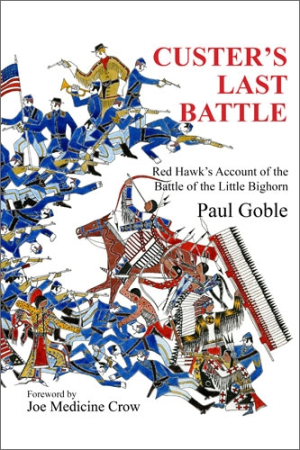Custer's Last Battle
Red Hawk's Account of the Battle of the Little Bighorn
- 2013 INDIES Finalist
- Finalist, Juvenile Fiction (Children's)
The last great battle of the Indian Wars comes alive for children and adults in accurate, illustrated text.
Custer’s Last Battle is a gorgeously illustrated, fictionalized yet well-researched account of the Battle of the Little Bighorn told from the point of view of a fifteen-year-old Oglala Sioux warrior. Though brief, each of the forty-four pages is enlivened by beautifully rendered, full-color ledger-book art, with drawings presented in a relatively bloodless manner suitable for the youthful audience at which it is aimed.
First published more than forty years ago, this new version by Wisdom Tales includes not only revised and updated text but also a brighter, more brilliant remastering of the illustrations. As author and illustrator Paul Goble says, his original art work was scanned and updated “in glorious digitized color.” Goble, who has won many awards as an illustrator since the original publication, has done a masterful job of not merely copying but perhaps improving on the “Egyptian perspective” of the “bright flat colors” and “detail drawing” style used by Native Americans in the nineteenth century. His drawings closely and faithfully mimic their own artistic depictions of the epic event and tell the story of Custer’s Last Stand so clearly and concisely that graphic novelists, filmmakers, and historians would be envious.
The text is short and simple. While fictionalized, it is drawn from firsthand accounts of participants fighting on the bluffs overlooking the Little Big Horn River in June 1876. As Chief Joe Medicine Crow, now ninety-eight, explains in the foreword to this new edition, “Goble’s retelling of the Custer battle” is not only “based on Indian sources. It is very accurate. So you can also learn the real story from this book.”
That story is a lively one, with fictional narrator Red Hawk’s excited prose interspersed with italicized historical sidebars to keep the whole story, and not just his role in the key part of it, in perspective. The narrative captures the thrill and excitement of a young boy in his first fight, as well as the fear and horror of hearing “horses and men crying out in pain” and seeing “the frightened faces of babies and little children running from the soldiers’ bullets.”
There are tales of courage on both sides. The great warrior Four Bears dies trying “to snatch a flag from a soldier’s hands” and men are “fighting with knives and tomahawks and empty guns for clubs.” Although told by the victor, the story does not denigrate the defeated. The author quotes the Indians’ commander, Chief Sitting Bull: “I will tell no lies about dead men. Those men who came with Long Hair were as good men as ever fought.”
Custer himself, the infamous Long Hair of the tale, gets off much easier than in most modern accounts of the battle. Although no longer the unsullied martyred hero of Western lore or Hollywood, the famed general (reduced in rank to colonel after the Civil War) comes across as courageous, if not overly bold to the point of foolhardiness. For that failing, Custer and the five companies of his regiment who followed him into action that day paid the ultimate price.
Although aimed at a young market, and described by the publisher as suitable for children as young as six, Custer’s Last Battle is a must for collectors or interested readers of books.
Reviewed by
Mark McLaughlin
Disclosure: This article is not an endorsement, but a review. The publisher of this book provided free copies of the book and paid a small fee to have their book reviewed by a professional reviewer. Foreword Reviews and Clarion Reviews make no guarantee that the publisher will receive a positive review. Foreword Magazine, Inc. is disclosing this in accordance with the Federal Trade Commission’s 16 CFR, Part 255.

